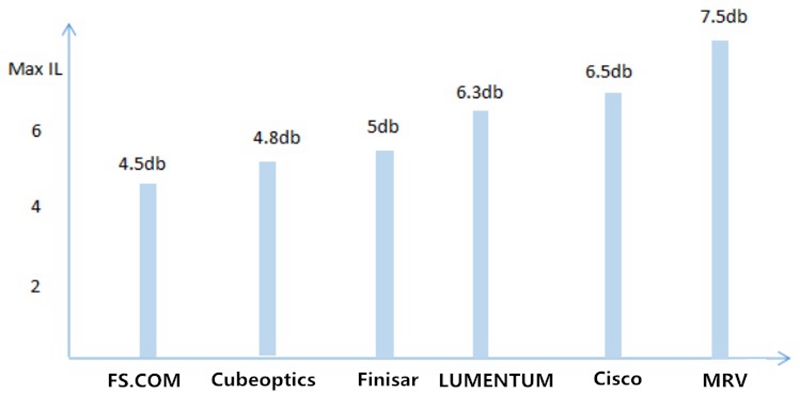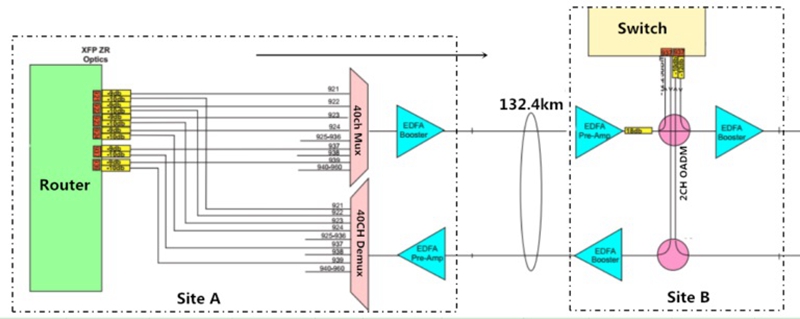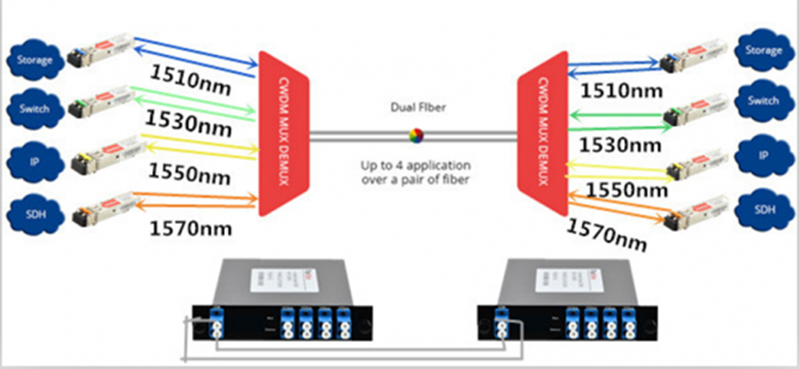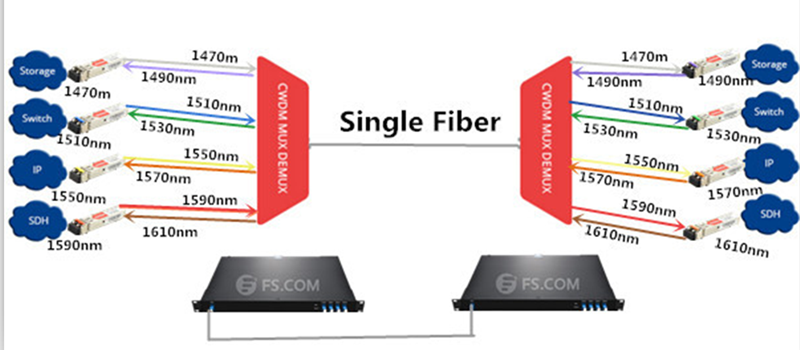April 20, 2017
As the optical network develops fast, today’s network needs much higher capacity than ever before, for carrying the large amount of data. Under this trend, the DWDM technology is come up with that can greatly expand the network capacity in long haul transmission. For those capacity-hungry applications, building a DWDM network is undoubtedly an economical solution that can transmit much more signals through only one singlemode fiber for a long distance. However, the DWDM network is very complicated which consists of various components like DWDM Mux Demux, EDFA optical amplifier and dispersion compensating module. Taking all these components into consideration, the detailed loss in the long haul DWDM network would be a puzzle for many users. To clear up the confusion, this paper will analysis what mainly cause the loss in the long haul DWDM network and learn how to calculate the loss budget in details.
What Mainly Cause the Loss in Long Haul DWDM Network?It is well known that any components inserted into the a network will cause loss, more or less. For instance, if a DWDM Mux Demux for multiplexing signals is deployed in the network, the insertion loss will occur. Hence, when designing a DWDM network, you are highly suggested to make the whole loss budget clear, for ensuring the performance of your network.
DWDM Mux Demux: a key component in the DWDM network. It is designed for multiplexing several kinds of signals with different wavelengths and then carrying the integrated signal through one fiber. Considering that Mux Demux is a passive component without the function of amplifying the signals, its big insertion loss will affect the whole network loss. In order to reduce the cost for deploying the DWDM network, it is very necessary to choose a DWDM Mux Demux with less insertion loss.
In recent year, most DWDM Mux Demux manufacturers dedicate the reduction of insertion loss. Since the insertion loss are still very different among these manufacturers, here offers a figure that shows their maximum insertion loss of the 40 Channel DWDM Mux Demux. From the figure, we can learn six common DWDM Mux Demux manufacturers who provide the 40 Channel DWDM Mux Demux. Among these manufacturers, FS.COM, Cubeoptics and Finisar offers the Mux Demux with relatively low insertion loss that are high recommended, while others don’t.
Optical Add Drop Mux: another component deployed in the DWDM network. From its name, it is easy to learn that it enables individual or multiple wavelength channels to be added or dropped from an incoming link. When it is working, the signal will pass from the common port to add/drop port or from the add/drop port to the common port. The insertion loss will be caused during the process.
Dispersion Compensation Module: plays an important role in DWDM network. When the optical signals are deformed by the chromatic dispersion in the transmission, we can use this component to reshape the deformed signals. As it is very useful for receiving the right signals and avoiding transmitting errors, it is required to be inserted in the receiver end of the DWDM network which also cause the insertion loss.
Other Components: apart from the mentioned components, the singlemode fibers can also cause loss in DWDM network. Moreover, the longer the transmission distance is, the higher the loss will be. In addition, the EDFA optical amplifier should be also noted. When the loss in the DWDM network is too high and can’t support the long transmission, the EDFA optical amplifier will be used for boosting or adding gain of optical signals. Hence, the signal power can be balanced and the long transmission can be done.
How to Calculate the Loss Budget for the DWDM Network?To understand how to calculate the whole loss budget, here offers a part of the long haul DWDM network deployment solution, designed by a user from UK. From the figure, we can learn the whole transmission distance is 132.4 km, from site A to Site B. The 40 channel DWDM Mux Demux, booster EDFA optical amplifier, pre-amplifier, 2 channel optical add drop mux and optical attenuators are installed for deploying the DWDM network. All these components will cause the loss or change and affect the whole network performance.
Now let’s calculate the budget loss from site A to site B:
A. The first loss of the link is caused by the use of an optical attenuator, between the router and the 40 channel DWDM Mux. It is -8.5dB.
B. When the signals pass through the DWDM Mux, the second loss, -4.5dB occurs. Then the output power is:-8.5dB-4.5dB =-13dB.
C. Then the signal will be boosted by the EDFA optical amplifier, and there is +23dB gain. At this time, the signal output power is: -13dB+23dB= +10dB.
D. Considering that the total loss of the fiber optic cable is: -0.22dB/km x132.4km = -29.13dB, the input power of the pre-amp EDFA is: +10dB-29.13dB = -19.13dB.
E. As the pre-amp EDFA gain is +26dB, so the output power is +6.87dB.
F. There is an attenuator with -18dB loss installed after the pre-amp EDFA. Hence, the output power after the attenuator is: +6.87dB-18dB = -11.13dB.
G. To enhance the signal, another EDFA optical amplifier installed in the receiver end. So that, the output power of site B is: +23dB-11.13dB=+10.67dB.
ConclusionSince there are various components like EDFA optical amplifier, dispersion compensation module, optical add drop Mux and patch cables needed for building a long haul DWDM network, the loss may occur many times during the transmission. Hence, calculating the loss budget before building the DWDM network is very necessary. Only by making the whole loss budget clear, the power loss in the transmission can be controlled and the whole DWDM network performance can be ensured.
Posted by: katherinewangfs at
09:59 AM
| Comments (11)
| Add Comment
Post contains 964 words, total size 8 kb.
April 13, 2017
CWDM, also referred to as coarse wavelength division multiplexing, is a kind of WDM technology that uses different wavelengths to multiplex two or more optical signals and carry them together via a single optical fiber, aiming at enhancing the network performance. Instead of putting more fibers to carry larger data volume, CWDM technology enables many virtual fibers to meet the increasing requirement of network capacity, as an economical cabling solution for fiber infrastructures. In principle, it can carry up to 18 wavelengths on a single fiber in the spectrum grid from 1270 nm to 1610 nm with a 20nm channel spacing, which can support the network at lengths up to 80 km.
In contrast with the DWDM channel spacing, the CWDM channel spacing is too large that makes its channel design not so complicated as the DWDM one. As a result, the optical signals in CWDM channels are not able to be amplified by the optical amplifiers as those in the DWDM channels. Accordingly, CWDM technology can not support the network as long as that of DWDM one. But on the other hand, the feature of wider channel spacing allows more moderate CWDM multi-channel Mux/Demux price and other CWDM equipment prices. In short, CWDM technology is an economical solution to deploy high capacity network with less fibers that reaches up to 80 km.
CWDM Mux Demux—a Key Component in CWDM NetworkWhen we talk about the key components in the CWDM system, the CWDM Mux Demux usually comes to our mind firstly that plays a critical role in the CWDM system. The CWDM Mux Demux modules are bidirectional optical multiplexers utilizing different wavelengths to combine multiple optical signals together and transmit them via a single fiber, which always work in pairs to support bidirectional transmission. In details, it can combine up to 18 signals with different wavelengths from 18 separate optical fibers, then transmit them together through a single optical fiber, and finally separate the integrated signal into individual signals again and send them to other 18 separate optical fibers. By this method, it can efficiently expand the network without the need of adding more fibers, which is really a high bandwidth but low cost solution for users.
CWDM Mux Demux for Dual Fiber CWDM NetworkThe CWDM Mux Demux used for building dual fiber CWDM network can be also called dual fiber CWDM Mux Demux, which is an universal device with the advantages of good performance and environmental stability. There are up to 18 CWDM wavelengths between 1270 nm to 1610 nm with 20nm channel spacing that can be used for the dual fiber CWDM Mux Demux. Just taking a 4 channel dual fiber CWDM network as an example, there are four kinds of wavelengths separately used for the two 4 channel CWDM Mux Demux and the ports on these two Mux Demux have the same TX and RX, as shown in the following figure. The signals with four different wavelengths transmitted from left to right should be multiplexed in the left Mux Demux, transmitted via the first single fiber and demultiplexed in the right Mux Demux, and vice versa for the transmission from right to left.
CWDM Mux Demux for Single Fiber CWDM NetworkAs for the single fiber CWDM Mux Demux, it is more complicated than the previous one that can be learned from the following figure. By comparison, there should be eight wavelengths used for a 4 channel single fiber CWDM network, which is the twice as much as that of a 4 channel dual fiber CWDM network. The eight wavelengths will be divided into four pairs separately used for the four channels and the TX and RX of the ports on the two single fiber CWDM Mux Demux are all reversed to finish the dual way transmission. For instance, the first port on the left Mux has 1470 nm for TX and 1490 nm for RX, while the first port on the right one has 1490 nm for TX and 1470 nm for RX. Hence, the first signal with 1470 nm can be transmitted via the single fiber from the left to the right, while the signal with 1490 nm can be also oppositely transmitted via the same fiber.
ConclusionCWDM solution is a cost effective choice for increasing the network capacity and promoting the network performance. By this method, you can use less fibers for sending the same amount signals. If you are facing the capacity-hungry issue, you are recommendable to use the compatible CWDM Mux Demux, CWDM transceivers, duplex or simplex singlemode patch cables and related CWDM equipment to build a high-capacity CWDM network.
Posted by: katherinewangfs at
08:17 AM
| Comments (4)
| Add Comment
Post contains 781 words, total size 6 kb.
35 queries taking 0.059 seconds, 79 records returned.
Powered by Minx 1.1.6c-pink.













